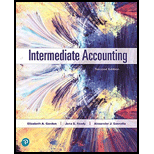
Intermediate Accounting Plus Mylab Accounting With Pearson Etext -- Access Card Package (2nd Edition)
2nd Edition
ISBN: 9780134833101
Author: Elizabeth A. Gordon, Jana S. Raedy, Alexander J. Sannella
Publisher: PEARSON
expand_more
expand_more
format_list_bulleted
Question
Chapter 14, Problem 1JC
a.
To determine
The list of criteria that differentiate between debt and equity assuming equity as common stock and debt as secured loan.
b.
To determine
Todetermine: The list of debt and equity attributes in the given four instruments that are
c.
To determine
The way in which each of the given instrument need to be classified under equity and debit.
Expert Solution & Answer
Want to see the full answer?
Check out a sample textbook solution
Students have asked these similar questions
provide correct answer
Correct Answer
Sunset Software has experienced high demand for its
cloud-based services. The company expects its earnings
per share (EPS) to grow by 18%, reaching $4.75 for this
year.
Estimate the market price per share (MPS) of the
company's stock assuming the industry's price/earnings
(P/E) ratio is 10.
Chapter 14 Solutions
Intermediate Accounting Plus Mylab Accounting With Pearson Etext -- Access Card Package (2nd Edition)
Ch. 14 - What conditions or terms does a note payable...Ch. 14 - If the market rate of interest exceeds the face or...Ch. 14 - What is included in bond issue costs and how...Ch. 14 - Prob. 14.4QCh. 14 - When a bond is issued at a discount, will its...Ch. 14 - Prob. 14.6QCh. 14 - Prob. 14.7QCh. 14 - Under IFRS, how do firms account for convertible...Ch. 14 - Prob. 14.9QCh. 14 - Can companies reclassify short-term debt expected...
Ch. 14 - Under IFRS, can companies reclassify short-term...Ch. 14 - Do companies always reclassify long-term debt that...Ch. 14 - Prob. 14.13QCh. 14 - Prob. 14.14QCh. 14 - Prob. 14.15QCh. 14 - Prob. 14.16QCh. 14 - Prob. 14.1MCCh. 14 - Prob. 14.2MCCh. 14 - Prob. 14.3MCCh. 14 - Prob. 14.4MCCh. 14 - Prob. 14.5MCCh. 14 - Clothes Horse Corp. (CHC) Issued 500,000 bonds due...Ch. 14 - Prob. 14.7MCCh. 14 - Prob. 14.8MCCh. 14 - Prob. 14.9MCCh. 14 - Prob. 14.10MCCh. 14 - Prob. 14.11MCCh. 14 - Prob. 14.1BECh. 14 - Notes Payable. Using the information provided in...Ch. 14 - Prob. 14.3BECh. 14 - Prob. 14.4BECh. 14 - Prob. 14.5BECh. 14 - Prob. 14.6BECh. 14 - Bond Terminology. Match each term with its...Ch. 14 - Bond Pricing. Fill in the missing items for each...Ch. 14 - Prob. 14.9BECh. 14 - Bond Issue Price. Using the information from...Ch. 14 - Prob. 14.11BECh. 14 - Prob. 14.12BECh. 14 - Prob. 14.13BECh. 14 - Prob. 14.14BECh. 14 - Prob. 14.15BECh. 14 - Prob. 14.16BECh. 14 - Prob. 14.17BECh. 14 - Prob. 14.18BECh. 14 - Bonds Issued between Interest Payment Dates. For...Ch. 14 - Prob. 14.20BECh. 14 - Prob. 14.21BECh. 14 - Prob. 14.22BECh. 14 - Prob. 14.23BECh. 14 - Prob. 14.24BECh. 14 - Prob. 14.25BECh. 14 - Prob. 14.26BECh. 14 - Prob. 14.27BECh. 14 - Prob. 14.28BECh. 14 - Prob. 14.29BECh. 14 - Prob. 14.30BECh. 14 - Short-Term Debt Expected to Be Refinanced, IFRS....Ch. 14 - Prob. 14.32BECh. 14 - Prob. 14.33BECh. 14 - Prob. 14.34BECh. 14 - Prob. 14.35BECh. 14 - Fair Value Option. Saratoga Company issued bonds...Ch. 14 - Prob. 14.37BECh. 14 - Financial Statement Disclosure. Use the following...Ch. 14 - Prob. 14.1ECh. 14 - Prob. 14.2ECh. 14 - Prob. 14.3ECh. 14 - Prob. 14.4ECh. 14 - Prob. 14.5ECh. 14 - Bond Issue, Interest Payments, Effective Interest...Ch. 14 - Prob. 14.7ECh. 14 - Prob. 14.8ECh. 14 - Prob. 14.9ECh. 14 - Prob. 14.10ECh. 14 - Prob. 14.11ECh. 14 - Prob. 14.12ECh. 14 - Convertible Bonds, Conversion. On January 1, 2018,...Ch. 14 - Convertible Bonds, Conversion. Using the...Ch. 14 - Prob. 14.15ECh. 14 - Prob. 14.16ECh. 14 - Prob. 14.17ECh. 14 - Prob. 14.18ECh. 14 - Warrants. DHC Associates issued 2,100 of its...Ch. 14 - Prob. 14.20ECh. 14 - Prob. 14.21ECh. 14 - Prob. 14.1PCh. 14 - Long-Term Notes Payable, Semiannual Interest,...Ch. 14 - Note Payable Issued at a Discount with...Ch. 14 - Prob. 14.4PCh. 14 - Prob. 14.5PCh. 14 - Bond Issue, Interest Payments, Effective Interest...Ch. 14 - Prob. 14.7PCh. 14 - Bonds Sold between Interest Dates at a Discount,...Ch. 14 - Prob. 14.9PCh. 14 - Prob. 14.10PCh. 14 - Convertible Bonds, Bond Issue Costs, Conversion....Ch. 14 - Prob. 14.12PCh. 14 - Prob. 14.13PCh. 14 - Prob. 1JCCh. 14 - Prob. 2JCCh. 14 - Prob. 3JCCh. 14 - Prob. 1FSCCh. 14 - Prob. 1SSCCh. 14 - Surfing the Standards Case 2: Bonds with...Ch. 14 - Prob. 1BCC
Knowledge Booster
Learn more about
Need a deep-dive on the concept behind this application? Look no further. Learn more about this topic, accounting and related others by exploring similar questions and additional content below.Similar questions
- What is the operating profit ? General accounting questionarrow_forwardSuppose Austin Sound had sales of $300,000 and sales returns of $45,000. Cost of goods sold was $152,000. How much gross profit did Austin Sound report? a. $148,000 b. $103,000 c. $255,000 d. $88,000arrow_forwardWhat is the ending inventoryarrow_forward
arrow_back_ios
SEE MORE QUESTIONS
arrow_forward_ios
Recommended textbooks for you
 Financial AccountingAccountingISBN:9781337272124Author:Carl Warren, James M. Reeve, Jonathan DuchacPublisher:Cengage Learning
Financial AccountingAccountingISBN:9781337272124Author:Carl Warren, James M. Reeve, Jonathan DuchacPublisher:Cengage Learning

Financial Accounting
Accounting
ISBN:9781337272124
Author:Carl Warren, James M. Reeve, Jonathan Duchac
Publisher:Cengage Learning

Financial instruments products; Author: fi-compass;https://www.youtube.com/watch?v=gvxozM3TUIg;License: Standard Youtube License